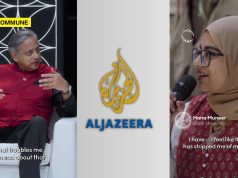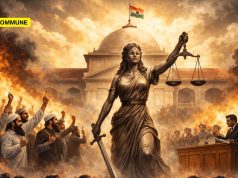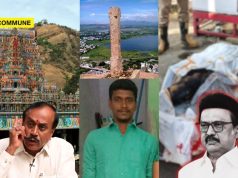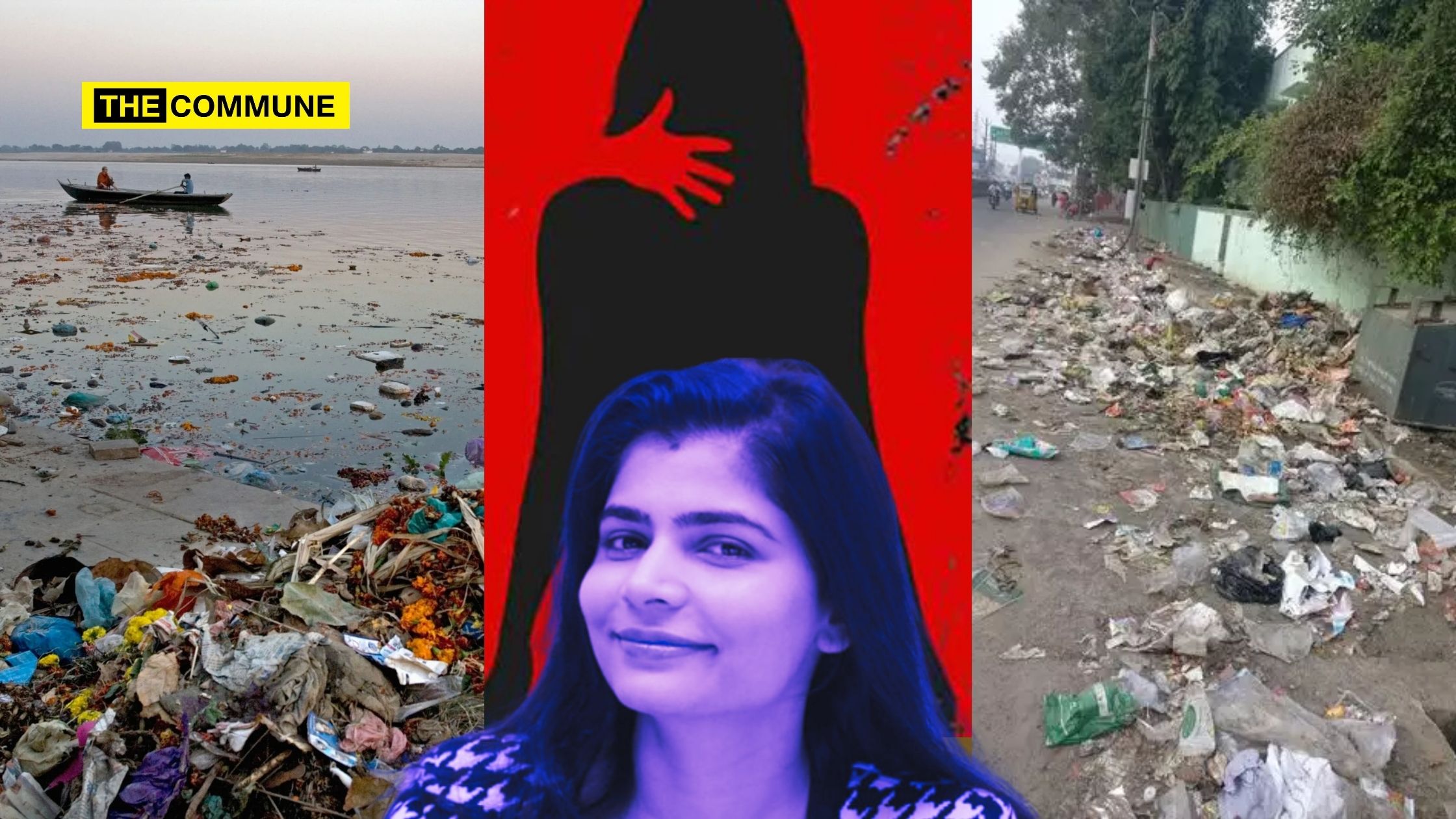
Chinmayi Sripaada, virtue signaller and “singer” known predominantly for her vocal anti-Hindu stance, recently shared a set of posts comparing India to other countries, implicitly blaming Hinduism for societal and infrastructural issues in the nation. In a series of four photos, she took aim at India’s struggles with pollution, road conditions, and women’s safety, contrasting these issues with the seemingly better conditions in non-Hindu countries, while conveniently omitting key factors that contribute to such problems.
🤷🏻♀️ pic.twitter.com/ey2ZOj2lT2
— Chinmayi Sripaada (@Chinmayi) October 20, 2024
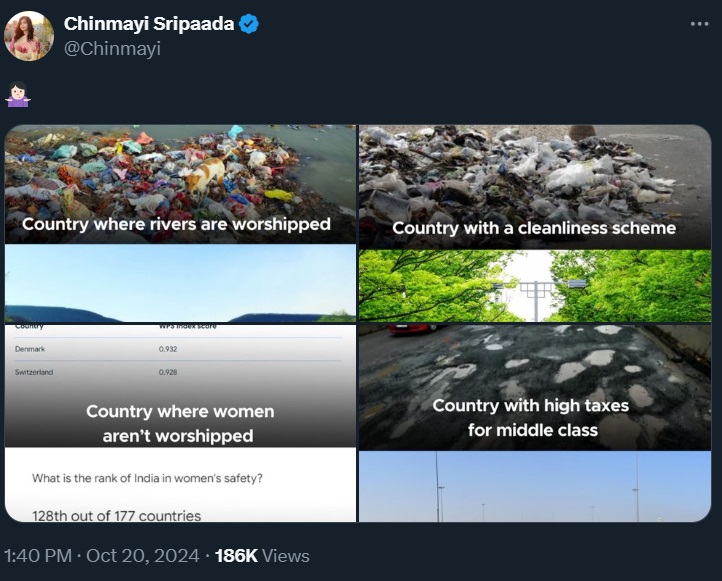
Her first photo showed an unclean river in India, a country where rivers are worshipped, compared to a pristine river in a nation that does not revere water bodies. In another, she posted an image of garbage-strewn streets in India, despite the existence of government cleanliness schemes, juxtaposed with a clean street from a country without such initiatives. Chinmayi went on to claim that Denmark, the safest country for women, does not “worship women” yet is far safer than India, which ranks 128th in safety despite its cultural reverence for women. Finally, she pointed out that India’s potholed roads are a reality despite high middle-class taxes, unlike smooth roads in countries with lower tax burdens.
What Chinmayi Ignores
Chinmayi’s post blatantly ignores essential factors like population density, per capita income, and civic awareness, all of which significantly impact these conditions. Her critique goes beyond infrastructure to suggest that religion itself is the problem, subtly blaming Hinduism for the country’s shortcomings. She conveniently disregards the cultural, economic, and historical contexts that play a major role in these issues, preferring to frame Hinduism as the scapegoat.
Moreover, her stance is as hypocritical as it can get, considering her silence on anti-Hindu rhetoric, such as the calls for the eradication of Sanatana Dharma in Tamil Nadu. It raises the question: why does she not critique those who openly attack the religion? Her selective outrage and targeting of Hinduism reveal a clear bias.
We are Hindu majority no?
Doesnt one entire lot blame all terrorism on another religion?I suggest you go bathe in the Yamina as of today.
— Chinmayi Sripaada (@Chinmayi) October 20, 2024
She also went on to blame Hindus for the alleged massacre of Jains in ancient history. She claimed that there was documented evidence that certain kings persecuted others, enforcing their own faith or different branches of Hindu beliefs. According to Chinmayi, this history highlights “periods of religious intolerance and persecution”, yet claimed that there was a tendency to deny or erase these “uncomfortable aspects” of the past.
Changing goal posts, she took the Dravidianist path bringing in “caste oppression within Hinduism: out of nowhere.
Hindu history has enough of massacres of Jains – these have been recorded in stone inscriptions.
Such persecutions by kings that everyone should follow their faith-offshoot or other offshoots of Hindu beliefs is in recorded history.
Denial helps nothing
Neither does erasure…— Chinmayi Sripaada (@Chinmayi) October 20, 2024
Chinmayi’s remarks also sidestep the reality of how many Western countries, now praised for their civic sense, were once far dirtier than present-day India. Europe, at one point in time, was infamous for its lack of hygiene, and even today, many Islamic nations outside the Gulf face similar civic challenges. The idea that civic sense is inherently linked to religious beliefs is reductive at best and misleading at worst.
In responding to criticism, Chinmayi doubled down, asking if India, being a Hindu-majority country, could not bear responsibility for its condition. She also drew a false comparison to how an entire religion is “blamed” for terrorism, suggesting that critics should consider her perspective on Hinduism similarly. Yet, her arguments remain flawed, as they ignore the broader picture of societal development, governance, and education.
Chinmayi’s attempts to virtue-signal by denigrating her own culture and religion ultimately fall flat. Instead of offering constructive solutions, she indulges in the blame game, targeting a faith that has endured and thrived for millennia despite countless challenges. Her selective criticism and apparent disregard for the complex issues at play suggest that her primary goal is not to improve society but to vilify a religion and culture she openly despises.
The Truth?
India needed a cleanliness scheme because of the failures of the past governments, and the lack of civic sense of its own people – the Swacch Bharat mission ensured there were toilets in the country and that cleanliness became a norm in the country.
Compared to the days before 2014, India is in a much better place when it comes to cleanliness.
- Toilets built: More than 117 million toilets have been built since 2014.
- Open defecation-free villages: Over 600,000 villages have been declared Open defecation-free (ODF).
- Infant mortality rate: Research suggests that the SBM may have saved 60,000-70,000 infant deaths annually between 2011 and 2020.
- Groundwater contamination: There has been a significant reduction in groundwater contamination in ODF areas.
Indore, the cleanest city in India, has been ranking first for 7 years. The Greater Chennai Corporation has been ranked 199th out of 446 cities in the Swachh Survekshan survey. According to officials, the city scored 4,313 points out of a possible 9,500 in the assessment for the year 2023.
Critics argue what Chinmayi has done for her country and her city instead of constantly whining about religion and everything else under the sun.
People like Chinmayi are so uninformed that she too has fallen for the perception that the middle class pays exorbitant taxes. A comparison with countries like Germany reveals otherwise. While India has a population of 144 crore, Germany’s population is 8.5 crore, and its per capita income is significantly higher (~$50,000 versus ~$2,900 in India). About 90% of Germany’s working population pays taxes, compared to only 9% in India.
For Indian middle-class earners (annual income of ₹6-18 lakh), the tax rate is around 12%, while top earners (above ₹25 lakh) pay approximately 17-18%. To reach a 25% tax rate, one would need to earn ₹55 lakh, placing them in the top 1%. In contrast, Germany’s top 8% earners pay between 25% and 42% in taxes, indicating that tax rates in India are relatively low, especially considering the country’s lower GDP per capita.
India’s infrastructure improvements also contradict claims of “services like Africa.” Railways are 93% electrified, the paved road network is expanding, and Swachh Bharat has drastically reduced open defecation, averting 180,000 diarrheal deaths. Furthermore, banking inclusion has surged from ~10% to ~80% in recent years, and digital initiatives like UPI and Aadhaar have revolutionized financial access.
But Chinmayi wants to randomly pick images from the past when our rivers and roads were unclean and randomly link Hinduism to her narrative.
This is not the first time she has played the same tune as the ruling party’s narrative. She has been a part of the anti-Hindi imposition gang of Dravidianists. While calling out lyricist Vairamuthu for sexual harassment, she refused to comment on the Dravidianists abusing Brahmins day in and day out.
Subscribe to our Telegram, WhatsApp, and Instagram channels and get the best stories of the day delivered to you personally.

